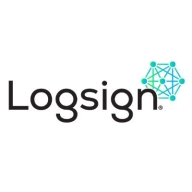

Logsign Next-Gen SIEM and DNIF HYPERCLOUD are robust security information and event management platforms. Users find DNIF HYPERCLOUD's features and value more compelling than Logsign Next-Gen SIEM.
Features: Logsign Next-Gen SIEM offers extensive integration capabilities, automation features, and is known for its user-friendly interface. DNIF HYPERCLOUD provides scalability, advanced analytics, and caters well to complex security needs with powerful performance features.
Room for Improvement: Logsign Next-Gen SIEM could benefit from enhanced threat intelligence, more intuitive setup processes, and better incident response workflows. DNIF HYPERCLOUD could improve its reporting capabilities, reduce the steep learning curve, and enhance usability in configuration processes.
Ease of Deployment and Customer Service: Logsign Next-Gen SIEM is recognized for straightforward deployment and prompt customer support. DNIF HYPERCLOUD requires more time for deployment but has comprehensive support and training resources. Users find Logsign simpler to deploy, but DNIF compensates with effective support.
Pricing and ROI: Logsign offers competitive pricing and satisfactory ROI, making it appealing for small to mid-sized enterprises. DNIF HYPERCLOUD justifies its higher price with superior scalability and long-term ROI. Though initially more costly, DNIF is seen as a worthwhile investment for larger organizations needing extensive security solutions.
| Product | Market Share (%) |
|---|---|
| Logsign Next-Gen SIEM | 0.7% |
| DNIF HYPERCLOUD | 0.7% |
| Other | 98.6% |


| Company Size | Count |
|---|---|
| Small Business | 3 |
| Midsize Enterprise | 1 |
| Large Enterprise | 3 |
DNIF HYPERCLOUD is a cloud native platform that brings the functionality of SIEM, UEBA and SOAR into a single continuous workflow to solve cybersecurity challenges at scale. DNIF HYPERCLOUD is the flagship SaaS platform from NETMONASTERY that delivers key detection functionality using big data analytics and machine learning. NETMONASTERY aims to deliver a platform that helps customers in ingesting machine data and automatically identify anomalies in these data streams using machine learning and outlier detection algorithms. The objective is to make it easy for untrained engineers and analysts to use the platform and extract benefit reliably and efficiently.
Logsign delivers automation-driven cyber security solutions and are committed to providing the smartest, easiest-to-use and most affordable cybersecurity detection and response solutions and value-added services. Logsign Next-Gen SIEM is an enterprise-grade SIEM, inline with our promise, it's easy-to-deploy, easy-to-use and affordable unlike the other enterprise-grade SIEM softwares.
We monitor all Security Information and Event Management (SIEM) reviews to prevent fraudulent reviews and keep review quality high. We do not post reviews by company employees or direct competitors. We validate each review for authenticity via cross-reference with LinkedIn, and personal follow-up with the reviewer when necessary.